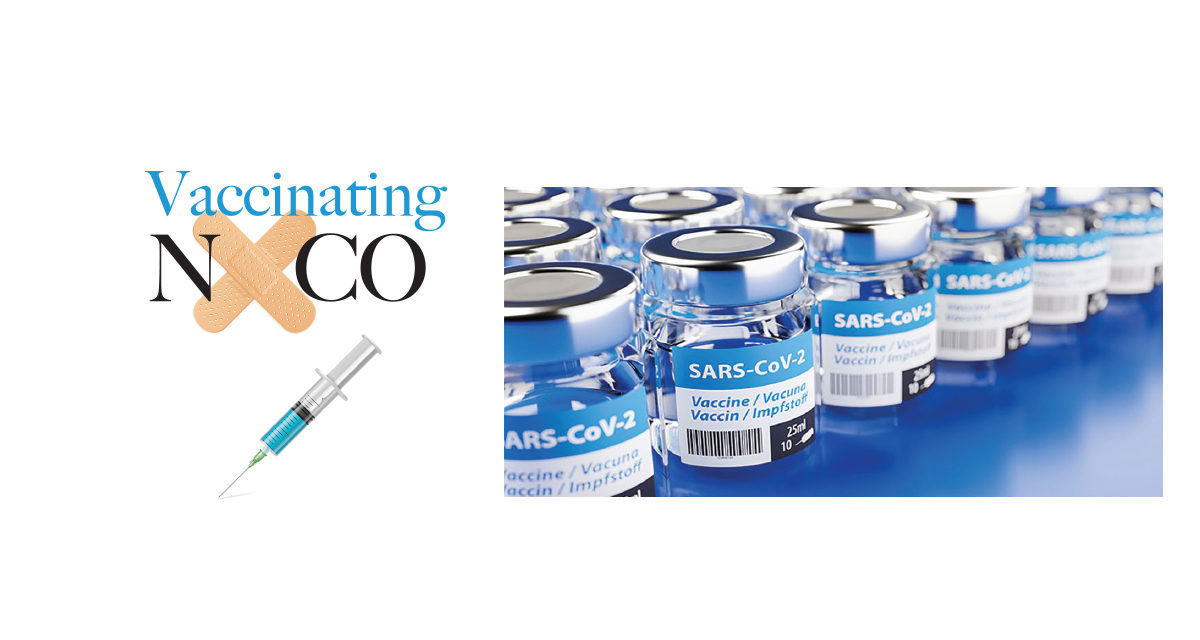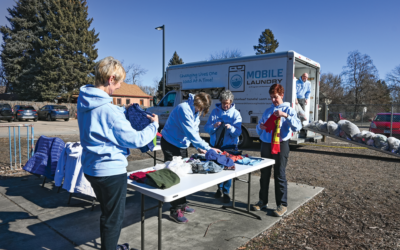By Dan England
Dick and Cookie Williamson, like so many of us in lockdown during the pandemic, just wanted their lives back. Dick, 86, needs oxygen all the time, and the coronavirus most likely would have been a death sentence. So, both he and Cookie, 70, were responsible.
They ventured out of their Greeley home only for the absolute essentials, such as food or toilet paper at the grocery store. Cookie, a retired nurse, was used to washing her hands. They took all the precautions. Yet, Dick and Cookie craved their old lives. Cookie, especially, enjoyed her bridge groups as a respite from caring for Dick. She found a place where a few of her friends could play together online, but it wasn’t the same. Dick missed his poker games with a club he formed in 1987. They hadn’t played in six months.
“I’m not a stay-at-home person,”Cookie says.
That’s why Cookie began calling around for the vaccine as soon as she heard it was available in Colorado. She called and called. Then she tried Sunrise Community Health in Greeley and found an appointment for her and Dick. On a Friday afternoon in mid-February, they traveled to a clinic in Loveland and received their first dose of a vaccine. Dick waved his March appointment card around like it was a golden ticket for Charlie’s chocolate factory.
“This is our first step toward freedom,” Dick said.
This, of course, doesn’t mean Sunrise is better than UCHealth, Banner or any of the Denver hospitals. It means that Cookie got herself a shot, as well as one for her husband, because she was persistent. Persistence was the key for those eligible for a shot even more than a month after the vaccine was released at the start of the new year.
That may be true as you read this in early April, because even as there are more vaccines out—Johnson & Johnson’s single-shot dose was released just in time to welcome March—as well as more doses of Moderna and Pfizer, there are more people eligible. The old saying is true: The squeaky wheel gets the grease. Only in this case, it’s a vaccination.

A guessing game of where’s the vaccine
As the vaccine began to roll out, health systems quickly realized the distribution of it was as unpredictable as the Colorado weather. Hospitals could request 10,000 vaccines and receive 1,000.
Some brands of the vaccine are extremely complex, with super-cold storage requirements, and it expires quickly. This was paired with an aging population who wasn’t comfortable with computers, the internet or smartphones that make it easier to notify people when a dose was available for them.
Still, people were frustrated. Kelly Lindner of Windsor spent weeks trying to get her fiercely independent grandmother, who is 81, a vaccine as soon as it was released.
“She called me after she reached out to Banner,” says Lindner, who is 39. “I mean, I’m not an IT person, but I do use the internet all day, every day, and I had trouble finding anything on it. If I can’t find the information, how do we expect my grandmother to do it?”
“It seems like it should be supereasy. You call this number, and they will vaccine you. But that’s not quite the case.” Richard Zane, UCHealth’s Chief Innovation Officer and an emergency room physician, is helping to lead the statewide efforts for UCHealth. He understands the frustrations, and he’s frustrated by them, too, because the short supplies, the difficulty handling them and the inconsistent delivery of them means that it’s not as simple as making a phone call for a vaccine appointment.
“The fact that we have a vaccineis miraculous,” Zane says. “It’s a generational achievement of science that will go down in history books. But there is also no chance people won’t be disappointed.”
What’s in the box?
Even in early March, two months after the vaccine was released, every time Sunrise Community Health gets a box of shots, it feels like Christmas.
That is, of course, partly becauseit’s a life-saving vaccine, and partly because as Dick put it, it’s our ticket to freedom. But it’s also because health officials at Sunrise have no idea what will be in the box.
“We can order it every week,” says Chalice Springfield, director of communications and development for Sunrise Community Health. “But that’s no guarantee. We might get zero, and we have some weeks.”
Sunrise tries to set up clinics ona weekly basis. They order it on Monday, and on Friday they learn what they’re getting. The following Wednesday the doses are delivered.
“It’s highly likely that amount Wednesday will be different than what we’re told we’re getting on Friday,” Springfield says in the first part of February.
“We’ve never had too much vaccine and not enough patients to give it to,” Zane says. “The biggest problem, and we continue to have this, is the inconsistency in the supply chain.”
Supply problems are the root of all the other problems that come with providing the vaccine. Sara Quayle, spokeswoman for Banner Health, says Banner officials didn’t want to talk, but it’s also probable that Banner officials believe the answer to any question regarding people calling over and over to try to find the vaccine is a simple one. “The registration process is pretty straightforward,” Quayle says. “The lack of vaccine is the problem.”
The reason why it’s much easier to get a flu shot, Zane says, is because the flu shot is plentiful. “We anticipate that 10-20 percent of the flu vaccine goes to waste,” he says. “There’s plenty of it. We err on the side of making more. This is the opposite.”
Therefore, UCHealth officials told themselves that they wouldn’t tolerate any wasted doses, Zane says. “A wasted dose is someone who didn’t have to die. I know that sounds dramatic, but that’s how seriously we approach it.”
Match game
UCHealth uses math, an algorithm, to predict response rates, which helps determine how many UCHealth can invite to a vaccination. Patients who get an invitation through UCHealth’s lottery system have 48 hours to claim it.
UCHealth wants to match thoseinvitations, and confirmations of them, with the number of available doses as close as possible. If UCHealth told patients they had a dose waiting for them, they were guaranteed a shot at their appointment.
When Sunrise gets vaccines, theylook at their waiting list and invite people based on who is first on the list. Sunrise, like UCHealth, will vaccinate anyone as long as he or she falls under the current eligible state guidelines. “We’ve had people drive two hours away to get one,” Springfield says.
The most effective method to inoculate people, at least as of early March, was for UCHealth to use its fixed clinics. The organization has 11 up and down the Front Range, and on any day, when a vaccine is available, they can do 2,500 in a day without any disruption to day-to-day operations. “Those fixed clinics are the workhouse,” Zane says.
Vaccinating the masses
You may have seen pictures of long lines in, say, Florida of elderly people waiting in line or in their cars on the highway for a vaccination. Zane says those are examples of mass inoculation events done the wrong way. There were likely no appointments and no attempt to match available doses with those who need one.
UCHealth did have one massinoculation event at Coors Field, but the longest anyone waited was 24 minutes, including the 15-minute waiting period to screen for serious reactions to it. The event vaccinated nearly 10,000 seniors at a drive-through event the last weekend in January, at 1,000 an hour. But there are limitations to mass events, even if they were initially touted nationwide as the solution to ending the pandemic.
“It was a Herculean effort,” Zane says. “It can get the most shots in the most arms, but it caused a major disruption. That will continue to have a role, but it’s an incredible thing to pull off.”
Plus gathering a lot of peoplein one area can cause other issues. Mandy Harding cares for her elderly mother, who has severe health issues, with the help of her father, who is 80 but healthy, in Johnstown. Harding lives with them, so when the pandemic hit, she turned down opportunities to meet with friends for more than a year and canceled her gym membership, even though she had lost more than 100 pounds in a focused attempt to improve her health.
They got a call for a vaccinationevent at Island Grove Regional Park in Greeley. They drove almost an hour to get there, even though it was the first time her mother had left the house since last March, and were surprised to find hundreds of people waiting. Her parents were taken to a long, curved hallway filled with people. Many of them weren’t six feet apart, and many weren’t wearing masks properly.
Both UCHealth and Sunrise saythey police distancing in the clinics, where many of the shots take place now. But that didn’t help Harding at the time. “It wasn’t a safe place for them,” Harding said in the first part of February about her parents. “So, they left. They still haven’t been able to get it.”
Reaching out
Harding’s problems with her parents are the same stories that many had in the first month or two of vaccinations, although those stories are now less common. But they also demonstrate the fact that not everyone has a smartphone or a computer, and that’s not just the elderly: Other populations that continue to confound them include lower-income families, non-traditional workers and, yes, even those who are nervous about the vaccine, misinformed about its dangers or simply don’t want it.
“It seems our most vulnerableare once again more vulnerable, and disparity does exist, even in this arena,” says Jeannine Truswell, president of the United Way of Weld County.
United Way worked with churches, organizations and hospitals to get the shot out, but there were many nationwide examples of wealthier residents getting the shot or even jumping the line over those who didn’t have the resources to do so. So, imagine those who are disconnected, either by choice or because they can’t afford the toys of technology.
“Of concern are the vulnerable who do not have internet access to sign up and cannot afford a newspaper or other media publications,” Truswell says.
Sunrise has had some successreaching out and partnering with Banner and UCHealth as well as Larimer and Weld county health departments. They target people of color and those who need affordable healthcare.
Zane says UCHealth must dooutreach to those who may have trouble getting a shot for whatever reason, even if that’s the least efficient way to vaccine people. “We must do that,” he says. “We must.”
The future looks bright
On March 3, the New York Times ran a story detailing hundreds of people across the country who continue to hunt for the vaccine. They hang around pharmacies hoping for an extra dose and drive to clinics in the hopes of getting the shot of a no-show. Pharmacists call them “vaccine lurkers.”
This fact doesn’t help Colorado residents feel better about the problems they’ve experienced, but, hey, things could be much worse. States such as Missouri didn’t have much information available even on state websites. Truswell’s brother had a hard time finding anything at all in Montana. At least in Colorado, persistence pays off. “I’m proud of Colorado,” Zane says.
President Biden announced in March that the U.S. would have enough vaccine for every adult American by the end of May, two months earlier than anticipated. There are several options available, including one made by Johnson & Johnson, that can be administered in a single dose. As you read this, things are most likely already better than they were when this article was written in the first part of March.
As of March, those vaccines were already paying off. Hospitalizations were already going down. Cases and deaths were in decline, especially for those among seniors who conceivably had the vaccine.
That leads us back to the Williamsons. When they left the clinic after their first dose, they were already talking about getting together for a card game again. Maybe in March, they said.
How to get vaccinated
Things to note:
- You don’t have to be a patient or customer to sign up for a vaccine with any store or hospital that has it.
- There is no charge for the vaccine. Some places may bill your health insurance for an administrative fee, but if you don’t have health insurance, you are still eligible for a vaccine.
- It’s possible that your favorite grocery store or pharmacy may have the vaccine available now, as many chains have them in Colorado. Follow the state department link below or go to a store’s specific website to sign up.
- It’s a good idea to sign up in several locations, including hospitals, stores and pharmacies, as you never know when someone may find a dose for you, but signing up with major health care providers is also a good idea, as they will likely get more doses. Persistence is the key.
- Go to covid19.colorado.gov for the latest information on places in Colorado to get vaccinated and who is eligible. The list of those eligible changes frequently, so check back often.
- Go to weldgov.com/departments/health_and_environment if you live in Weld County, and larimer.org/health for Larimer County for information and to be put on a notification list if you meet requirements for a higher-risk group.
How to sign up with major health care providers:
Go to uchealth.org/covidvaccine to get onto UCHealth’s waiting list and receive information. UCHealth also has a hotline at 720.462.2255. There is a Spanish-language phone number at 844.945.2508. The hotline can also translate for more than 100 languages.
Go to sunrisecommunityhealth.org to sign up for the waiting list.
Go to bannerhealth.com/staying-well/health-and-wellness/wellness/covid to sign up or call 844.549.1856.
Dan England is a freelance writer who lives in Greeley. To comment on this article, email letters@nocostyle.com






